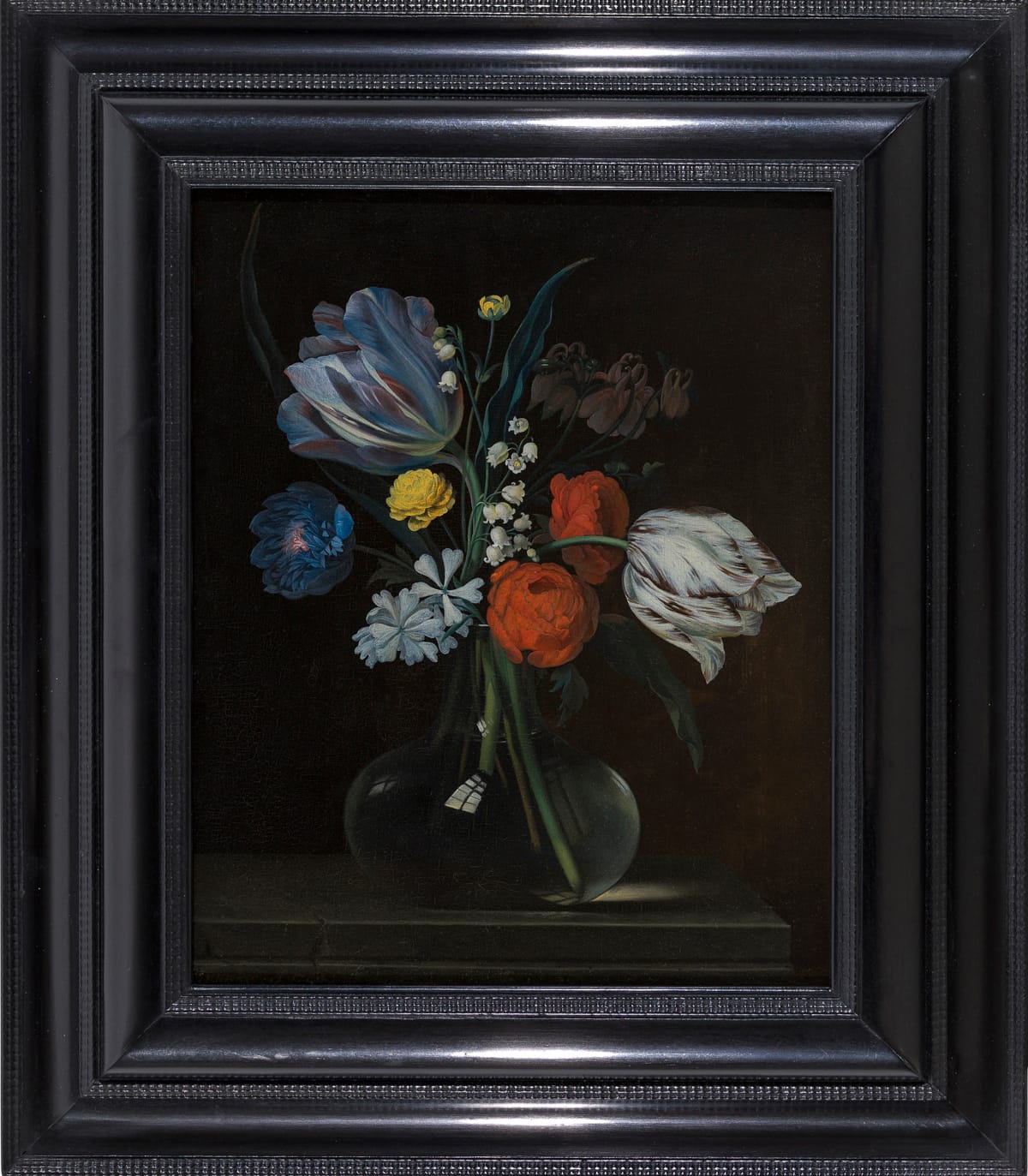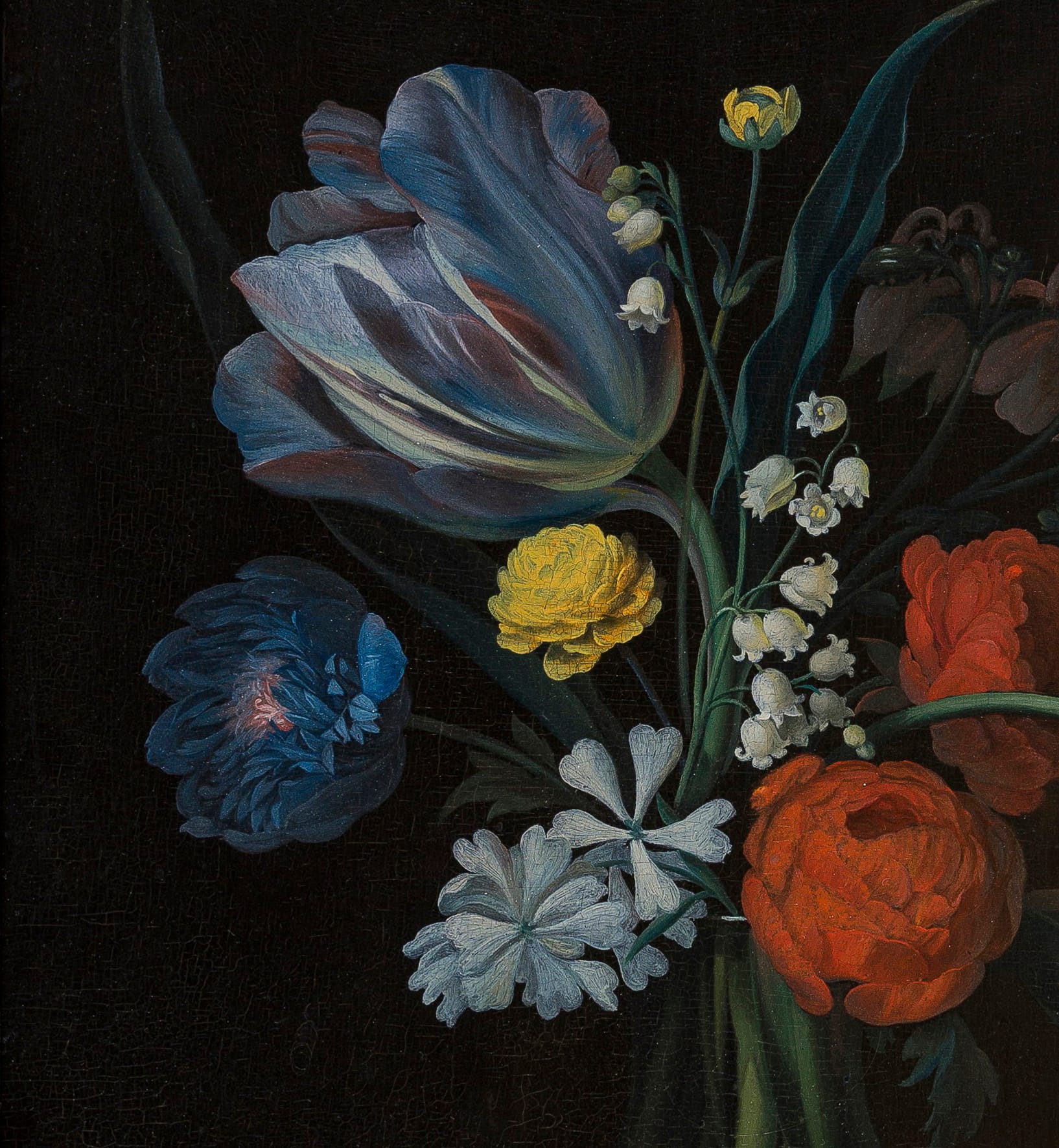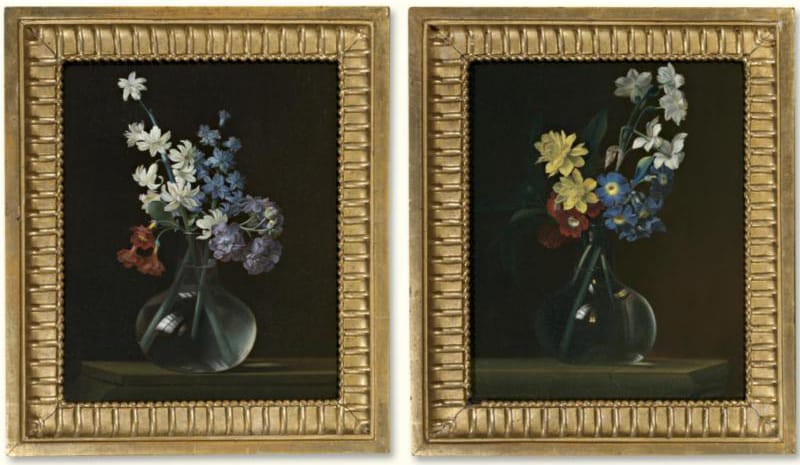JUSTUS JUNCKER (Mainz 1703 – 1767 Frankfurt)
Justus Juncker (Mainz 1703 – 1767 Frankfurt)
Still Life with Flowers in a Glass Vase
Oil on panel, 30.5 x 25 cm (12 x 9.8 inch); presented in an ebonised ripple frame
Signed and dated lower left ‘Juncker. 1764’
Provenance
Private collection, Austria
***
Justus Juncker was born in Mainz and moved to Frankfurt as a child, where he was taught the art of painting by Johann Hugo Schlegel.1 As with other painters of the so-called ‘Frankfurter Mahler’ (Frankfurt painters), Juncker was deeply influenced by Dutch artists of the Golden Age.2 Many examples of their works could be seen in the city, and the Frankfurt historian Heinrich Sebastian Hüsgen estimated in 1780 there were no less than eighty private collections with Dutch seventeenth-century paintings. Juncker was particularly inspired by paintings in the collection of Baron Heinrich Jakob von Häckel, notably works by Thomas Wijck. Juncker married in Eschborn in 1722 and settled in Frankfurt in the following year. In his turn, he taught his son Isaak Juncker and his son-in-law Johann Daniel Bager. The artist is thought to have worked in London before 1726.
Juncker specialised in still-life paintings of flowers and fruit, but also produced genre paintings.3 The artist is considered among the most talented eighteenth-century German painters. He is mostly known for receiving commissions from Johann Caspar Goethe after the death of his mother in 1754 – Johann Caspar was the father of the celebrated German writer Johann Wolfgang von Goethe (1749–1832), and like his celebrated son he had undertaken a journey to Italy in 1740, which he documented in his Viaggio per l’Italia. The greatest influence on the young Goethe’s artistic education occurred when a French officer serving in the Seven Years War, François de Théas, Comte de Thoranc, was given rooms in the Goethe house.4 Thoranc admired the paintings that Johann Caspar had collected and decided to commission some 250 paintings from Frankfurt artists, for which a studio was installed in the house – formerly Wolfgang’s own attic room. From 1759 to 1762 these Frankfurt artists frequented the Goethe house, much to the amusement and wonder of the young Goethe. It was exactly the truth-to-nature and faithful realism of these followers of the Dutch Golden Age painters that appealed to the young Wolfgang.
Even after Thoranc’s departure, Johann Wolfgang continued to be fascinated by the local Frankfurt painters, describing his dealings with them in his autobiography Dichtung und Wahrheit. Writing about Juncker, from whom his father had just commissioned another still-life, Goethe recounts: ‘It happened to be springtime and I never failed to take him several times a week the finest flowers I could lay my hands on, which he then at once fitted into the picture, and then gradually created out of these objects a most faithful and conscientious composition. On another occasion I happened to have caught a mouse which I also brought him; this charming creature appealed to him so much that he wanted to portray it as well, which he duly did in the most accurate detail as it nibbled an ear of corn at the base of the flower pot. More of these in-offensive natural objects, such as butterflies and beetles, were procured and depicted, so that in the end, as far as imitation and execution were concerned, a very estimable picture had been put together.’5
The present recently discovered still-life was painted by Juncker in 1764, exactly around the time of his intense contacts with the young writer. In excellent state of preservation, it shows the awareness of painters like Jan Davidsz de Heem and Jan van Huysum, while retaining Juncker’s idiosyncratic own style, particularly his attention to meticulous observation. This is for instance illustrated in the rendering of the glass bottle, which shows no less than six reflections of windows in Juncker’s studio, a masterly observation. Although his genre paintings are fairly common, flower still-lifes by Juncker such as the present work are rare. It can most closely be compared to a pair of flower still-lifes sold at Sotheby’s in 2006 (fig.).6
Paintings by Juncker are preserved in the collections of the Städel Museum, Frankfurt, the Goethe Museum, Frankfurt, the Wellcome Collection, London, Brighton & Hove Museums and Nostell Priory (National Trust).
1. For the artist, see the biography in Saur Allgemeines Künstlerlexikon: die bildenden Künstler aller Zeiten und Völker, Munich 1992- , vol. 78 (2013) p. 495.
2. See Adolf Feulner, ‘Der junge Goethe und die Frankfurter Kunst’, Freies Deutsches Hochstift, Festgabe zum Goethejahr 1932, Halle 1932.
3. See Horst Gerson, Ausbreitung und Nachwirkung der holländischen Malerei des 17. Jahrhunderts, Amsterdam 1983, pp. 322-323 and 364.
4. For the influence on Goethe by these Frankfurt painters, see W.D. Robson-Scott, The younger Goethe and the visual arts, Cambridge 1981, pp. 1-16.
5. Johann Wolfgang von Goethe, Gedenkausgabe der Werke, Briefe und Gespräche, ed. Ernst Beutler, Berlin 1949–, vol. X, p. 171.
6. Both oil on panel, 28 x 22.5 cm, Sotheby’s, New York, 26 January 2006, lot 145 (sold $60,000).







